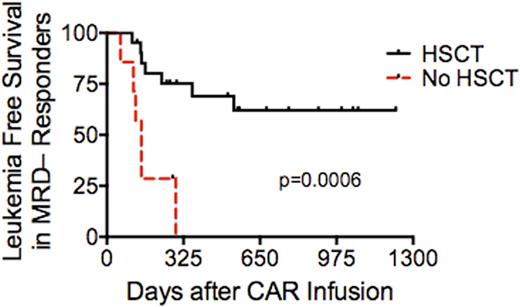Abstract

Relapsed pre-B acute lymphoblastic leukemia (ALL) portends a poor prognosis even with hematopoietic stem cell transplantation (HSCT). CD19 chimeric antigen receptor (CAR) T cells have shown promise in early studies although morbidity related tohigh gradecytokine release syndrome (CRS) and/or neurotoxicity could limit its wide applicability in patients with high disease burden. The lympho depleting chemotherapy regimen may affect both toxicity and response and has not been well studied. Relapse rates among complete responders to CD19 CAR therapy occur in nearly half of patients in the first year. We report outcomes from our completed clinical trial of 53 children and young adults with relapsed/refractory ALL (n=51) or lymphoma (n=2) with a median follow up (mF/U) of 18.7 months.
The first 21 patients received a low dose fludarabine (25 mg/m2/day Days -4 to -2) and cyclophosphamide (900 mg/m2 Day -2) preparative regimen (LDflu/cy) and results are reported in Lancet 385:517-28. The regimen for the subsequent 32 patients, who all received 1x106 CAR+ T cells/kg, was stratified based on disease burden. Subjects with low burden ALL (lowALL; <25% marrow blasts) received LDflu/cy while those with high burden disease (highALL; >25% marrow blasts or lymphomatous disease) received an alternative regimen [FLAG (n=6), ifosfamide/etoposide per AALL0031 (n=2) or fludarabine (30mg/m2/day Days -6 to -3) and cyclophosphamide (1200 mg/m2/day Days -4 and -3) (HDflu/cy; n=8)] in an attempt to mitigate severe CRS risk and improve response. Four highALL subjects received LDflu/cy due to comorbidities including Trisomy 21. CRS was graded and anti-cytokine therapy was instituted as per Blood 124:188-95. Date for data cutoff was July 31, 2016.
Of the 53 subjects 11 had primary refractory ALL, 5Ph+, 3 with Trisomy 21, 4 with CNS2 and 2 with CNS3 ALL including one with extensive leptomeningeal and parenchymal involvement. Cells were manufactured in 7-11 days and none underwent a test expansion. One patient was not infused due to rapidly progressive fungal pneumonia but was accounted for in all analyses.
Of 51 ALL patients, 31 (60.8%) achieved a complete response (CR) with 28/31 (90%) of responders negative for minimal residual disease (MRD-). All 6 subjects with CNS ALL were rendered into CNS1 status with resolution of leptomeningeal enhancement, where appropriate, and CAR cells in CSF. The median leukemia free survival (mLFS) of MRD- CR responders is 18 months with a 49.5% probability of LFS beginning at 18 months (mF/U 22.6 months). Grade 3 (n=5) and 4 (n=2) CRS combined for a severe CRS incidence of 13.5%. Three grade 3 neurotoxicities(1 each: dysphasia, delirium, headache) and 2 seizures (one grade 1, one grade 2) occurred. There were no grade 4 neurotoxicities, even in the subject with extensive CNS disease.
Subjects with low ALL had a significantly higher CR rate (18/21; 85.7%) than those with high ALL (13/32; 40.6%) (p=0.0011) and use of a flu/cy regimen correlated with higher response (29/44; 65.9% vs 2/8; 25%; p=0.0301). Overall survival in all subjects receiving a flu/cy regimen was 13.3 months with a 34.7% probability of survival beginning at 38 months (mF/U 18.7 months), which is significantly longer than those who did not receive a flu/cy regimen (5.5 months, no survivors beyond 11 months). The hazard ratio (HR) of not receiving a flu/cy regimen was 6.35 (1.906-21.14; p=0.0026). mLFS of subjects with MRD- CR who received a flu/cy regimen was not reached with a 53.3% probability of LFS beginning at 18 months (mF/U 22.6 months).
Of the 28 subjects achieving MRD- CR, 21 had a subsequent HSCT with a median time to HSCT of 54 days from CAR infusion. 8/28 (28.6%) relapsed with CD19+ (n=2), CD19-/dim (n=5), CD19 unknown (n=1) blasts. Relapse was significantly more common in subjects who did not have a HSCT after CAR therapy (6/7; 85.7%) compared to those who did (2/21; 9.5%) (p=0.0001). Even accounting for transplant related mortality, them LFS in the HSCT group was not reached with a 62% probability of LFS beginning at 18 months. This is significantly longer than them LFS of 4.9 months in MRD- CR subjects who did not proceed to HSCT (p=0.0006) with a HR of 16.9 (3.37-85.1) of not having a subsequent HSCT.
In all, CD19 CAR T cell therapy was effective and safe with a low incidence of severe CRS and neurotoxicity. In this nonrandomized series, the rate of durable remission was higher when a flu/cy preparative regimen was used and consolidation HSCT was employed.
Lee:Juno: Honoraria. Kochenderfer:bluebird bio: Patents & Royalties, Research Funding; Kite Pharma: Patents & Royalties, Research Funding. Rosenberg:Kite pharma: Research Funding. Mackall:NCI: Patents & Royalties: B7H3 CAR.
Author notes
Asterisk with author names denotes non-ASH members.

This icon denotes a clinically relevant abstract



This feature is available to Subscribers Only
Sign In or Create an Account Close Modal